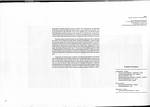|
|
 |
 |
AUSCHWITZ:
Technique
and Operation
of
the Gas Chambers © |
|
|
| |
 |
Back |
 |
Contents |
Page 112 |
 |
Home
Page |
Forward |
 |
| |
Drawing D58,173, probably dating from
January or February 1941, represented the very latest thing (at the time!) in
Topf coke-fired single muffle furnaces, using a minimum of metal parts in its
construction [Photo 3].
The muffle door was now of the "guillotine" type. This drawing was
sent to KL Mauthausen, probably in connection with a project for one of the
subcamps. It is not known whether the furnace was actually installed or not.
The furnace characteristics were similar to those of a Kori single muffle
furnace already installed in Mauthausen in May 1940 [Photos 3a, 3b and
3c].
Historically, D58,173, which has nothing to do
with Birkenau, makes it possible to understand the structure of the twinned
four muffle furnace ["Doppel-Vieormuffelofen"] created by Prüfer
to increase the capacity of his "conventional" furnaces in order to
meet the demands of the SS (the final stage of evolution was to be the
combination of Prüfer's science and the SS's experience: a circular
open air furnace based on the principle of the cremation pits). Composed of two
four-muffle furnaces constructed as a unit, this furnace, known as the
"eight muffle furnace", was to inspire the building of Krematorien IV
and V. The recesses for the guillotine doors are visible on Bauleitung drawings
1678 and 2036 of the future Krematorium IV (and V). While no survivor from the
Sonderkommando had thought to describe these muffle doors, which differed from
those of the three muffle furnaces in Krematorien II and III, the longitudinal
section shows the mechanism.
Technically, this drawing makes it
possible to reconstitute the arrangement of one half of a four muffle furnace
(in fact invariably twinned to give an eight muffle furnace), which was just
like two single muffle furnaces, mounted side by side. However, the location of
this firebox (es) [one or two for the four muffle unit] remains to be
determined (somewhere at the rear and to the side, on a lower level than the
muffles and accessed by a stoking pit ["Heizgrube"]. It should be
noted that neither this drawing nor the two others show the paths of the
secondary draught channels. It could be that these were deliberately omitted by
the Topf D division drawing office, who did not want to reveal all the details
of their cremation techniques, designed essentially by Prüfer. |
| |
| |
Photo 3
[Bundesarchiv Koblenz, NS 4 Mauthausen/54]
Betr. SS
Neubauleitung KL Mauthausen /
Re: SS Construction Management, KL Mauthausen
Topf Drawing, Scale 1:25, No. D57 173
Drawn [January or February] 1941
Einmuffel Einäscherungsofen /
Single-muffle crematorium
furnace
|
|
| |
|
Translation of
inscriptions: |
|
| |
|
|
|
| |
[Longitudinal section]: |
|
| |
· |
Absperrschieber /
Sliding ["guillotine"] door |
|
| |
· |
Ascheentnahme /
[Human] ash removal |
|
| |
· |
Rauchkanal / Smoke
flue |
|
| |
· |
Einäscherungsraum / Cremation chamber [muffle] |
|
| |
· |
Druckluftleitung /
Pulsed air duct |
|
| |
· |
Generator / [Coke
fired] hearth |
|
| |
|
|
|
| |
[Cross-section] |
|
| |
· |
Rauchkanalschieber /
Flue damper |
|
| |
· |
Rauchkanal / Smoke
flue |
|
| |
|
|
|
| |
[Horizontal section] |
|
| |
· |
Druckluft-Gebläse / Pulsed-air blower |
|
|
| |
AUSCHWITZ:
Technique and operation
of the gas
chambers
Jean-Claude Pressac
© 1989, The Beate Klarsfeld Foundation |
 |
Back |
Page 112 |
Forward |
 |
|

